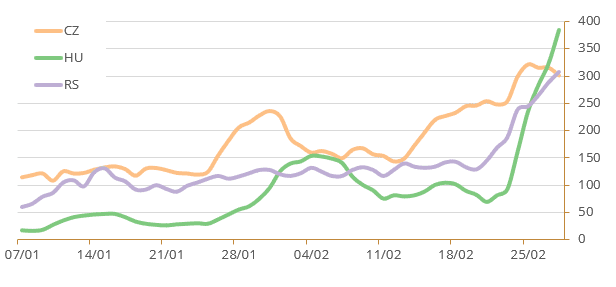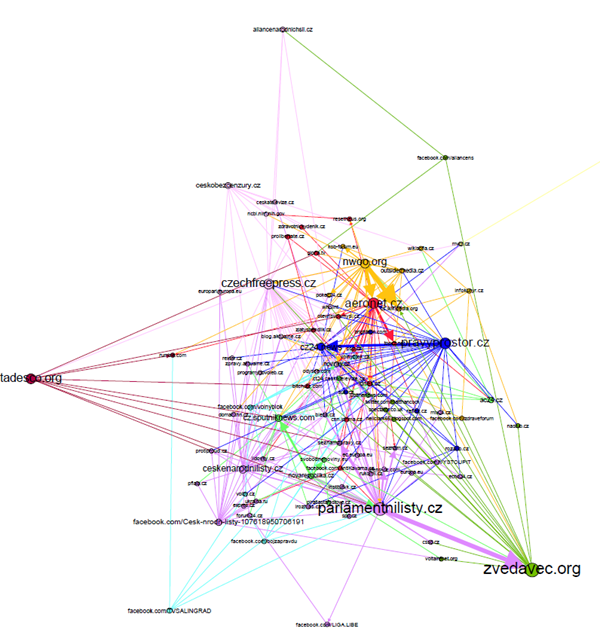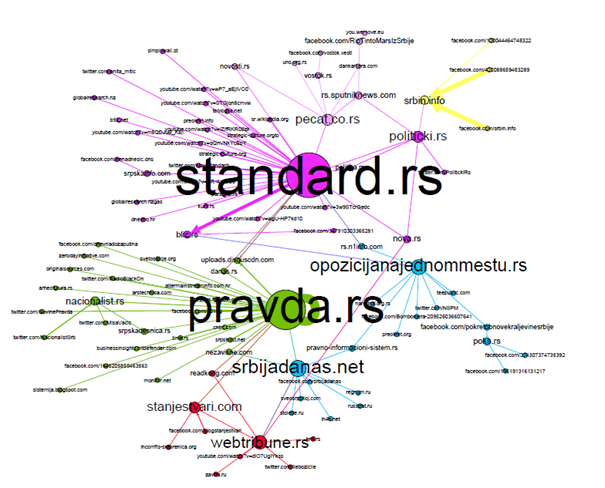by Lóránt Győri, Political Capital Institute
The Russian invasion of Ukraine has activated a broad media and movement network in support of the war effort in Central-Eastern Europe, which not many people are aware of. Novel research conducted by the Hungarian Political Capital Institute, the Serbian European Western Balkans, the International Republican Institute, as well as the Czech Prague Security Studies tried to piece together the puzzle made up of colourful pro-Russian actors working in the “shadows” or the “grey zone” of the internet to disseminate the Kremlin’s tactical and strategic narratives in service of the war.
Supported by the Open Information Partnership, Political Capital and its partners conducted an over 6-months long media qualitative and quantitative research into domestic and foreign malign influence exerted over the political campaigns to the run-up of the 2021 Czech elections and the 2022 April elections in Serbia and Hungary. Research results also shed light on how clandestine disinformation campaigns carried out by the so-called “grey zone” media contributed to the Russia-led regional destabilization efforts in the information space of Central-Eastern Europe after the invasion of Ukraine.
The media outlets monitored by the research disseminated well-known Russian disinformation narratives, the number of which skyrocketed after the launch of the invasion, about Ukrainian fascists killing Russian civilians in Donbas or the Russian “special operation” aimed at the “de-Nazification of Ukraine.” Others blamed the EU and NATO for their “continual sanctions and incitement of instability,” or published President Putin’s speech translated into Hungarian about “stopping the Ukrainian attack against Eastern Ukraine” and countering NATO’s illegitimate expansion eastward, which allegedly threatens the basic security needs of Russia.

The number of weekly war-related media content items (social media posts/website articles) dealing with the war in the Serbian, Hungarian, Czech grey zone media between 1/1-28/2, 2022 (7 day rolling average)
After a careful analysis of the sources of these messages, including the hyperlinks connecting these media, it turned out that they are a product of a shady media ecosystem comprised of mostly either the media of nationalist/far-right parties, movements or fringe media of anti-vaccination movements established in the wake of the COVID-19 epidemic after March 2020. All the media under investigation cooperated with each other in the dissemination of a total of 9750 messages per month through a network of 238 outlets.
The grey zone media networks in Central-Eastern Europe
What connects nationalist and anti-vaccination media in Central-Eastern Europe turned out to be the three core issues of (1) national sovereignty, (2) anti-Western ideology, mostly in the form of anti-US or Eurosceptic positions, and the (3) affinity for political conspiracy theories exploited for political, economic, health or other reasons. On top of their anti-establishment nature, most of these media preferred to stay in the “shadow” or “grey zone” in terms of their lack of editorial, financial or organisational transparency in order to disseminate extremist views unhindered, maximise ad revenues or the size of their audiences.
In the Czech Republic, nationalist media of the “grey zone” concerned mostly conspiracy or clickbait media with non-transparent ownership, organisational or editorial structures, such as Pravý prostor, New World Order Opposition, and CZ24 News – some with over a million visitors per month (CZ24 News), according to Similarweb. Whereas the new Czech anti-vax movement’s communication infrastructure is reliant on rather transparent new media and social media accounts headed by public faces to acquire political legitimacy. Examples include Otevřeme Česko – Chcípl PES (We Will Open Czechia – PES/DOG Croaked), TV Šalingrad, or Srdcem pro vlast (Heart of the country) – sites commanding an online audience of hundreds of thousands and an offline followership of thousands during street protests. Even though Sputnik news was banned by the European Union after the invasion of Ukraine, the Czech version was an integral part of the Czech grey zone media network, as displayed below.

The clean Czech grey zone media network diagram and its main clusters (subgroups of nodes with similar positions in the network; node size is proportional to the number of connections [edges]; k-core=3, only those nodes are visible that have at least 3 edges)
“It was a mistake to interfere in the internal affairs of other countries! (…) Both Brussels and Poland are responsible for the situation [on the border – ed.]!‼ (…) We are seeing the result of Poland’s Russophobic, irresponsible policy! It is sad that we must write this, but our Polish friends are making a serious mistake by constantly trying to thwart Russia and Belarus! The EU, led by Poland, has not recognised the results of the Belarusian elections (…).”
According to our analysis, the Hungarian hybrid-regime of Viktor Orbán plays a central role in the establishment, financing and coordination of the nationalist half of the grey zone ecosystem. Although investigative research could not prove direct organisational or financial contacts between governmental actors and anonymous pro-government sources, content- and network analysis revealed that pro-government outlets under investigation follow the governmental domestic or foreign policy rhetoric closely while referencing the social media pages of FM Péter Szijjártó or PM Viktor Orbán constantly. Additionally, other semi-transparent grey zone media, such as the Megafon Centre GONGO established in 2020 to train pro-government “Facebook warriors,” spent more than HUF 1 billion on its pro-government influencers’ and experts’ Facebook campaigns before the Hungarian elections, fervently denying that it received any public money – in spite of investigative data proving the opposite.
The new Hungarian anti-vax movement spearheaded by a small circle of alternative “health experts” calling themselves Orvosok a Tisztánlátásért (Doctors for Clarity) adopted both an anti-government and anti-West, more specifically, anti-USA political platform. They are either accusing the Hungarian government of trying to curtail Hungarians’ rights under the disguise of the pandemic or claiming that the Western political leaders – e.g., Bill Gates, George Soros, or Anthony Fauci – have “artificially” created the pandemic in collusion with pharmaceutical companies to make money, cut down the global population or subdue China. Their anti-West political agenda was suddenly extended to Russia after the launch of the invasion of Ukraine. The political arm of the movement, the Normal Life Party (Normális Élet Pártja) has issued an unexpected press release in favour of the war:
“We are in favour of a military pacification of the region, even by the Russian side, as long as it is aimed at (…) minimising the suffering of the Ukrainian population and sparing the country’s infrastructure. (…) We condemn the fact that the Atlantic bloc, with its expansion and the deployment of newer and newer weapons systems, continues to provoke Russia.”
Nevertheless, one of the main motivations of the Hungarian anti-vax leaders concern more than fame or ideology, it is also about money earned in alternative health businesses offered as remedies against the COVID-19 infection. A case in point is the “vitamin empire” owned by one of the most prominent members of Doctors for Clarity, Lenkei M.D., which had a gross turnover of HUF 3.5 billion in 2020 alone.
In contrast, the Serbian “grey zone” media ecosystem is made up of almost exclusively nationalist media that differ in their critical or supportive attitude to the Vučić-regime. The most relevant grey zone outlets are anonymous hyper-partisan outlets close to the government, such as Beograd, and mostly anonymous conspiracy/clickbait sources with an anti-government nationalist position, such as Webtribune or Srbija Danas. Still, these do not differ significantly in their positive coverage of the Kremlin, regardless of their domestic political position. The central nodes are all pro-Kremlin sites in the Serbian grey zone network, as seen below: the opposition outlets of Standard or Pravda, with Russian the state-owned Sputnik Srbija (rs.sputniknews.com) formulating the key messages about the war disseminated by the purple cluster or subgroup of media around Standard.

The central clusters (subgroups of nodes with similar positions in the network) of the Serbian grey zone network displayed in different colours around Standard, Pravda (node size is proportional to the number of connections or edges)
Modus operandi of foreign autocratic influence in the CEE
Based on the qualitative and quantitative network and content analysis, including the results of the investigative research conducted in each country, we were able to identify one central mechanism and three local components of foreign autocratic influence exerted through the grey zone media in Central-Eastern Europe.
On a very basic level, the pro-Russian or pro-Chinese foreign policy of the grey zone media is a result of the “cross-pollination” or “mutual radicalisation” between the far-right/nationalist subcultures and the new anti-vax movements. Whereas new anti-vax movements radicalise and mobilise new anti-establishment segments of the populations that boost extremist movements all across the board, the far-right subculture successfully injects (geo)political conspiracy theories into the new anti-vax community. Furthermore, the anti-West or pro-East radicalisation is supported by extremist ideologies, agents of influence or the lack of the general transparency of grey zone media.
Extremist ideology
In all three countries, the oldest and most established “core media” of the grey zone was created by extremist political actors that fundamentally view the West, the United States, the European Union, or NATO as supranational structures trying to crush nation states or national sovereignty. So, nationalist actors consider Russia or China as a much welcomed “counter-balance” to the West. The anti-West propaganda disseminated by far-right or nationalist actors seems to have a significant impact on electorates. Euroscepticism is the main driving factor behind the Czech anti-Western attitudes, with a significant portion of the electorate exhibiting an anti-EU sentiments or even supporting Czexit: 27% of Czechs would support leaving the European Union, according to the Globsec Trends 2021.
Agents of influence and hybrid regimes
The presence of foreign autocratic influence in the grey zone is also assisted by the infiltration of its ranks by mostly domestic and, occasionally, foreign agents of influence. For example, the recently re-activated anonymous Facebook page of the pro-Russian Hídfő.ru (Bridgehead) was founded by the disbanded neo-Nazi and paramilitary organisation Magyar Nemzeti Arcvonal (Hungarian National Front), who trained together with GRU agents and received some funding from them for their cooperation prior to 2016. However, the more significant infiltration is domestic in nature: the strategic communication of the Hungarian and Serbian hybrid regimes has incorporated the “grey zone media strategy” into their centralised communication to move beyond their core audiences and disseminate propaganda to non-aligned or even opposition voters, including their pro-Eastern foreign policy messaging.
Guns for hire
The general lack of organisational, financial, or editorial transparency also makes it very likely that some of the grey zone media will follow a pro-Kremlin or pro-Chinese rhetoric for money or other benefits. The investigative portal Átlátszó revealed that one of the anonymous hyper-partisan outlets in support of the Hungarian government, Minden Szó (Every Word), was founded, along with 11 other new media and social media accounts, by a software engineer named László Gerendás, living in the rural town of Esztergom. Additionally, the new Czech anti-vax movement is reliant on a crowdfunding scheme that resulted in the collection of hundreds of thousands or even millions of Czech crowns from donors by Otevřeme Česko – Chcípl PES or Zdravé forum (Healthy Forum), which provides access to Czech media networks for foreign or domestic malign influence.
Countermeasures
Since the grey zone media represent a serious challenge to the national security of the Central-Eastern European region and Ukraine – in the forms of new anti-West mass-mobilisation of societies, or the Kremlin’s disinformation narratives disseminated by hundreds of new, social media outlets – EU and NATO member states, the Euro-Atlantic Community would need to consider the following five countermeasures:
- An EU-wide ban on local pro-Kremlin media outlets should be considered as part of the next phase of the sanction’s regime, similar to the ban in effect against for example Sputnik or Russia Today.
- The European Parliament should consider a comprehensive social media strategy that would prevent media from simply migrating from one social media platform to avoid sanctions.
- Big service providers, such as Google, or Facebook, should be required to gut ad revenues flowing to extremist and/or anti-vax actors, and media.
- The fact-checking activity carried out by the EU’s European External Action Service should dedicate resources to the broader grey zone ecosystems, which transcend the usual circle of well-known pro-Kremlin or pro-Chinese outlets.
- Finally, hybrid regimes should be held to account for their propaganda activity executed via the grey zone media.







